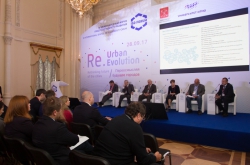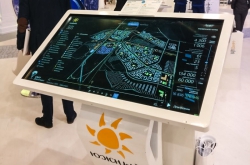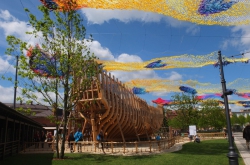What kind of research are you working on with ITMO University?
The University of Amsterdam has already worked with ITMO University on a crowd behavior study at the Kumbh Mela festival in India last year. The event involves approximately 65 million people, all gathered on a relatively small territory. Additionally, at last year’s VK Fest we studied the attendants’ movements by giving out tracking devices to visitors. It’s very interesting to observe how crowd behavior differs in various countries depending on the people’s cultural values and social norms. All of this could be used to gain an understanding of what factors can lead to harmful scenarios like, say, stampedes.

Tell us about some of the most unusual discoveries you’ve made when studying urban networks?
Most of my work concerns modeling large-scale complex systems, such as urban processes and human behavior. Together with other researchers we’ve discovered a few interesting things. For instance: one of our projects dealt with traffic simulation in Singapore. We’d gathered a lot of data from traffic systems, i.e. navigation apps and created a traffic simulation to model the outcomes of various changes. And one of the ideas we had was to see how the drivers’ usages of navigation systems affects traffic. Imagine a situation where each driver is aware of which routes are currently congested. If the driver is presented with two paths to his destination and he knows from the navigation app that one of them has a traffic jam, he will choose the alternate route. The problem here is that this creates even more congestion with all of the drivers transitioning between the routes.
We’ve found that there are several roads in Singapore that make the traffic situation worse – when they are closed, the whole network becomes more efficient! This is known as the Braess’ paradox: a small change in the road network – a closing of a certain road – improves the network’s overall efficiency. This is particularly relevant in relation to roads that lead to speedways. Closing those roads spreads the traffic towards other, less utilized routes.
While working in Singapore we’ve discovered another nuance. The authorities there sometimes close roads in the downtown area, which leads to better traffic status not just in the city itself, but also its general area. The reason is that people simply use their cars less when they know that the city center is inaccessible by automobile.

Traffic is the bane of all major cities. What other relevant issues of urban development are there?
Crowd control. ITMO University and University of Amsterdam are constantly performing studies in this field. Cities grow bigger and bigger and governments of countries such as China, India or Japan realize that they need to care not just about traffic, but also citizens’ mobility and public transportation. These systems are interdependent and a flaw in one could cause them all to collapse. For example, if a subway train is delayed, a whole chain reaction of errors and jams soon follows. This is why it’s very important to track and study the interaction between crowds in such complex systems. Another big issue in major cities is construction of residential buildings is densely populated areas. Such projects greatly affect traffic in the area. A partial solution would be the creation of commercial and working spaces closer to such areas or, inversely, building of residential buildings in vicinity of existing offices and services.
City planning research is absolutely necessary. But how much time will pass until politicians begin to react to the research findings?
Quite a lot. It’s one thing to run a simulation and demonstrate the right solutions in a virtual environment, but it’s very different for a government. That’s why authorities tend to try and test new solutions slowly and carefully, as even the smallest miscalculations in such projects can be catastrophic. I’ve spoken to the scientists who developed the integration strategy for self-regulating “smart” traffic lights in Dresden. They developed the idea in the 90’s and only began testing it after 10-15 years of “pushing” for it. I think that the adoption of smart city technologies is a responsibility of both scientists and governments. It’s also necessary to constantly explain to the populace why city systems need to evolve and change. The public opinion shouldn’t be underestimated. You can’t just close a road and tell people it’s for the better – they need to understand how it works.

Then how do you deal with older cities where nothing can be changed? For example, the whole downtown area of St. Petersburg is a world heritage object where very few things can be redone.
I think St. Petersburg has it better than many other European cities. The streets in London and Amsterdam, for instance, are even narrower than here, as they were not built for cars. Communications and traffic systems are rarely ever built according to a predetermined design; they evolve with the city. Amsterdam solved that problem well by developing its bicycle system. Same with Copenhagen, where cyclists have priority over drivers.
This approach, then, ends up hurting the drivers’ interests… So how do you please everyone?
That is an extremely difficult task. The government of one of India’s fastest-growing cities, Bangalore, wants to utilize Amsterdam’s experience in solving urban issues. For a society to accept such ideas, people need to be taught a different set of values and rules of behavior from an early age. For instance, children need to be taught how to ride a bike. Same with drivers: when they see themselves surrounded by cyclists and that they should give priority, they treat the situation differently. But it takes at least one or two generations for such things to change. Urban dynamics will also change with the emergence of self-driving vehicles and personalized public transit. I think we’ll see a completely different picture on the roads in 50 years.
Will the concept of car-sharing gain traction?
We also studied this in Singapore. There is a lot of taxi traffic in the city – up to 30%, in fact – as owning a personal car is very costly there. We’ve collected GPS data from various cars about where people tend to pick up cabs and where they are usually dropped off. Then we’ve modeled systems in which 25% or 50% of taxi passengers would share their cabs with other riders who had a similar route. These simulations showed that even slight changes in traffic volume have a great effect on traffic. The speed at which this system might become adopted by the populace depends on various factors, such as cultural values, the passengers’ personal concerns regarding safety and comfort, as well as the drivers’ opinions on the matter.

Another question we wanted to ask: do the people affect the city or does the city affect them? For example: in recently constructed densely-populated areas, the paths inside residential blocks are laid down according to a predetermined plan. Yet they aren’t always optimal, so people create their own paths over lawns. This angers me, as I am the kind of person who’d rather use the less-optimal paths and enjoy the sight of untouched lawns. Is this because those people just have different lines of thinking that disagree with mine?
That’s a great example. To answer your question: it goes both ways; cities affect people and the people’s behavior affects the infrastructure. There is usually a certain city plan and people all react to it differently. It’s been known for a long time that, when crossing a square field, people will tend to cross it from corner to corner. So if people are allowed to decide where those paths should be, urban designers can adapt to crowd behavior and modernize the infrastructure on the go. But infrastructure, too, affects people. There is research that shows that tall buildings negatively affect people’s minds, their psychological state. And so those who design city territories need to account for that influence as well as people’s perception of their environment. Here’s an example: tourists in an Italian town were asked to walk to a train station by three different routes and then asked about their impressions. The city authorities would be able to improve their city’s design based on that feedback. This is a great idea: urban environments can be molded gradually – not from scratch, but based on the citizens’ needs, always adding something, changing things. Still, this could misfire and cause chaos, as there are many kinds of people, all with different preferences: some want a shorter path, some want a pretty lawn. Which is why this is indeed a complex problem.





